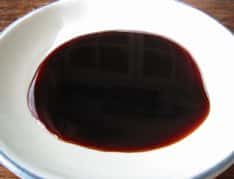Soy Sauce (Shoyu)
What Is Shoyu (Japanese Soy Sauce)?

Authentic shoyu is created using soybeans, cracked, roasted wheat, salt and water. These are combined with a special mold starter called koji (also used in sake production) which converts the starches to sugars. The resulting mix (called moromi) is then allowed to ferment for up to three years in giant vats.
The resulting liquid is filtered, blended, and aged to achieve the proper balance of flavors, much like wines and distilled spirits. Many modern commercial soy sauces, however, are made with hydrolyzed soy protein, coloring, additional flavors, and preservatives, so check the ingredients label for just the aforementioned ingredients if you want authentic Japanese soy sauce.
Often, you will pay a higher price for the real item because it is a craft condiment that takes time and care to make instead of the cheaper brands that cut costs to make a “soy sauce-like” product, which can still be legally labeled “soy sauce” as it contains soy.
Tamari – The Original Soy Sauce
The ancestor of shoyu is tamari, which was (and still is) made from only fermented soybeans, salt, and water, however in the 1640’s, tamari manufacturers began experimenting with adding wheat to the mix, and thereby producing a liquid with much much more depth of character that the original tamari.
Thus was born what we know today as shoyu, or Japanese soy sauce. So for those who may have a gluten intolerance, tamari is often a safe option instead of soy sauce, though we recommend you ask to be sure that your tamari is truly wheat-free if you would like to try this option at a restaurant, or look at the ingredients label on any bottle you buy.
I have always been fascinated by the creation and culture of different foods, particularly sushi and sashimi in the modern era of Japanese cuisine. I am a classically trained chef and sushi connoisseur, also having operated a food service company and enjoy investigating and experimenting with food around the world.